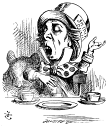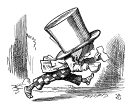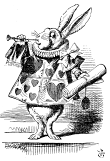Search us!
Search The Word Detective and our family of websites:
This is the easiest way to find a column on a particular word or phrase.
To search for a specific phrase, put it between quotation marks. (note: JavaScript must be turned on in your browser to view results.)
Ask a Question! Puzzled by Posh?
Confounded by Cattycorner?
Baffled by Balderdash?
Flummoxed by Flabbergast?
Perplexed by Pandemonium?
Nonplussed by... Nonplussed?
Annoyed by Alliteration?

Don't be shy!
Send in your question!
Columns from 1995 to 2006 are slowly being added to the above archives. For the moment, they can best be found by using the Search box at the top of this column.
 If you would like to be notified when each monthly update is posted here, sign up for our free email notification list.
If you would like to be notified when each monthly update is posted here, sign up for our free email notification list.
Trivia
All contents herein (except the illustrations, which are in the public domain) are Copyright © 1995-2020 Evan Morris & Kathy Wollard. Reproduction without written permission is prohibited, with the exception that teachers in public schools may duplicate and distribute the material here for classroom use.
Any typos found are yours to keep.
And remember, kids,
Semper Ubi Sub Ubi
|
Filching food from the Trustees’ Luncheon probably didn’t help.
Dear Word Detective: I notice you frequently feature slang in your columns, but what is the etymology of the word “slang” itself? Is it a blending of “language” (or perhaps “langue”) and the “‘s” from the preceding possessive noun? Or am I just being fanciful? — Steve Giannelli, Athens, OH.
Hi there, Athens, Ohio, which is generally considered to be the Athens of Ohio. Hey, it beats being the Akron of Ohio. Just kidding. Athens is a lovely town, and bears the twin distinctions of being home to Ohio University and, not entirely coincidentally, the only place where I have actually been ordered to leave town by the local police. Something about “aggravated mopery and inciting to skepticism,” as I recall. But that was many years ago, and I shan’t hold it against your fair city.
It’s true that I often write about the roots of slang, primarily because slang terms tend to be both more fun and more mysterious in origin than “standard” English words and phrases. My readers also tend to ask about slang terms more often, which is not surprising since one of the characteristics of slang is that it tends to be the distinctive vocabulary of an “in” group (even if that group is quite large, such as teenagers) and designed to be unintelligible to those not in the group (such as adults).
Oddly enough, linguists have been arguing for more than a century about precisely how to define “slang.” In a 1978 article in the journal American Speech, linguists Bethany Dumas and Jonathan Lighter suggested four criteria, meeting any two of which would qualify a term as “slang”: (1) use of the term lowers “the dignity of formal or serious speech or writing,” (2) its use implies familiarity with the thing itself or a with group familiar with the thing (e.g., calling motorcycles “choppers”), (3) its use would be forbidden or avoided in conversation with persons of greater social status (e.g., you wouldn’t say “groovy” when your boss asks how lunch with a client went), and (4) it replaces a conventional synonym that the user wishes to avoid for various reasons (e.g., saying a relative “croaked” rather than “died”).
Given that slang has proven so hard to define, it’s not surprising that the origins of the word “slang” itself, which first appeared in the mid-18th century, have proven equally elusive. Your theory tying “slang” to the “lang” in “language” is actually one of the two most commonly proposed explanations of “slang.” The possessive “s” in such phrases as “thieves’ language” or “gypsies’ language” could indeed have been blended into “slang.”
The other leading theory of “slang” traces it to Scandinavian roots, in particular the Old Norse “slyngva,” meaning “to sling,” found in the Norwegian “slengenamn” (“nickname”) and “slengja kjeften,” meaning “to verbally abuse” (literally “to sling the jaw”). Personally, I find this the more plausible of the two theories, but the Oxford English Dictionary and other reputable etymological sources don’t find either theory convincing and still label “slang” as “origin unknown.”
And whoooom shall I say is calling?
Note: This column originally ran (and was sent to subscribers) in December, 2008.
Dear Word Detective: An article about a congresswoman who hung up on the President-elect (because she thought it was a prank call) referred to the congresswoman’s “flack.” Surely a new word, I thought (wrongly). I gathered that it meant something like a spokesperson, and sure enough, both Merriam-Webster online and my 2nd edition American Heritage confirmed that it refers to a press agent. MW says it has been around since 1939 (as long as some of my cousins!) Both MW and American Heritage say origin unknown, although a rather weird site called the Visual Thesaurus relates it to “flak” (anti-aircraft fire). This seemed to me an iffy connection. What have you got for me? — Charles Anderson.
Good question. Incidentally, I saw that congresscritter (as Molly Ivins used to call them) explaining her actions on TV, and I’m on her side in this ruckus. There’s a serious shortage of skepticism in this country. I can, for instance, call my local bank and ask for my balance, giving only my account number. Of course, I also have to answer the Secret Security Question, which is “What’s your name, Hon?” Maybe I should keep my pennies somewhere that doesn’t have a live bait vending machine in the parking lot.
Visual Thesaurus is a rather weird website. I went there to see what they say about “flack,” but their fancy-schmanzy interface froze my browser. In any case, they’re not the only folks trying to trace “flack,” meaning a spokesperson or publicity agent, to “flak,” meaning literally “anti-aircraft fire,” and, figuratively, “harsh criticism.” But while both “flack” and “flak” are part of the vocabulary of public relations, there is no connection between the two words.
“Flak” is a relic of World War II, when German anti-aircraft guns were known as “Fliegerabwehrkanone,” literally “pilot defense guns.” The initial letters of the constituent parts of that word spell “flak,” and the acronym was picked up by Allied pilots who also used it to mean the cannon fire itself. “Flak” first appeared in print in English in 1938, and in its literal sense produced such forms as “flak jacket” (body armor) and “flak happy” (affected by “shell shock,” or what we now call PTSD).
By 1968, “flak” was being used in its now more common figurative sense of “adverse criticism,” which led to Tom Wolfe coining the term “flak catcher” (in his 1970 book “Radical Chic & Mau-Mauing the Flak Catchers”) for a public relations agent who deals with unfavorable publicity.
“Flack” is a product of the same period, first appearing in print (as far as we know) in 1937. Although many dictionaries list the origin of the term as “unknown,” a magazine called “Better English” reported in June 1939 that the show-business newspaper Variety was, at that time, “trying to coin the word ‘flack’ as a synonym for publicity agent,” adding that “the word is said to be derived from Gene Flack, a movie publicity agent.” While I do not have access to the archives of Variety from the 1930s, it seems unlikely that “Better English” simply made up the item. Assuming the story is true, “flack” is an eponym, a noun formed from a proper name, in this case immortalizing a man who spent his life trying to immortalize movie stars.
But if I put this bag on my head, I am invisible. I know because nobody talks to me when I do.
Dear Word Detective: I would like to know the origin of “up to par” and “up to snuff.” In golf being over par is not a good thing, so being “up” to it should not be a good thing. “Up to snuff” makes no sense to me as a positive term other than snuff goes up the nose. — John N. Pierre.
Hmm. I was under the impression that we weren’t supposed to stick things up our noses. I recall that lesson as one of the few things I learned in third grade, right up there with the indigestibility of chalk and the fact that tying a towel around one’s neck does not confer the ability to fly. It’s really a miracle that some of us ever make it to puberty, isn’t it?
Onward. That’s a good question. “Up to par” and “up to snuff” mean roughly the same thing, and are both used to describe someone or something that meets a certain common standard of sufficiency or well-being. Both of them also date back to the 19th century, although “up to par” is the more recent of the two, first appearing nearly 80 years after “up to snuff.”
“Snuff” is, of course, powdered tobacco, usually inhaled through the nose. Snuff has been in use since tobacco was first cultivated, and was extremely popular in Europe and America from the 16th through the 19th centuries. The word “snuff” in this sense is shortened from the Dutch word for the stuff, “snuftabak,” obviously related to “to snuff” meaning “to draw in through the nose,” a word formed in imitation of the sound of the action itself. Etymologists are not sure if “snuff” in the sense of “to extinguish a candle” (or, in slang, “to kill”) is related to this sniffling “snuff.”
The best clue to the logic behind “up to snuff” comes from the fact that when the phrase first appeared in the early 19th century, it didn’t mean simply “meeting a standard” as it does today. It meant “shrewd, sharp, sophisticated and not easily deceived,” and it was applied to people who were wise to the ways of the world. Since snuff was, at that time, largely a habit of adult men of comfortable means (it wasn’t cheap), it seems reasonable to assume that “up to snuff” meant “the sort of person who appreciates and uses snuff,” i.e., a worldly man. It’s also possible that the original sense was of a man who was sophisticated enough to tell high-quality snuff from the cheap stuff. The use of “up to snuff” to mean “meeting a common standard” arose later in the 19th century.
“Up to par” doesn’t actually have anything to do with golf. “Par” (from the Latin “par,” meaning “equal”) was originally, at the end of the 16th century, a term in economics denoting the value of one currency in terms of another. By the mid-18th century, “par” had taken on the broader meaning of “an average or expected amount or condition,” which gave us such idioms as “above par,” “under par” and, by the late 19th century, “up to par,” meaning “meeting the expected standard.”
The same period saw the first use of “par” to mean the maximum number of strokes a good golf player should need for a particular hole or the entire course. Of course, given the rules of golf, the whole point is to avoid finding yourself “up to par,” especially when you’re only halfway through the course. At that point, the only thing to do is tie a towel around your neck and hope for the best.
|
Makes a great gift! Click cover for more.  
400+ pages of science questions answered and explained for kids -- and adults!
FROM ALTOIDS TO ZIMA, by Evan Morris
 
|


 can be found
can be found 




Recent Comments